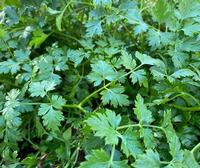Chervil
Chervil, Anthriscus cerefolium, is one of the classic fines herbes used in French cooking (parsley, chives, and tarragon are the others). It has lacy leaves similar to parsley, but smaller and more delicate. Use chervil in ways similar to parsley - in soups, salads, sauces, and egg dishes. The leaves are prized for their slight anise flavor and contain a volatile oil that disappears when cooked, so for best flavor add chervil to hot foods just before serving.
How to grow
Chervil tends to bolt in warm weather, so it's easiest to grow in the cooler months. To ensure fresh leaves throughout summer, make succession plantings every 3-4 weeks.
- Type: Annual
- Light: Full sun to partial shade (especially in summer)
- Soil: Well amended, good drainage
- Water: Moderate, prefers moist soil
- Size: 10–16" high, 10–12" wide. Space plants 15" apart.
When to plant/propagate
- From seed: Direct sow, spring through fall. Cover seeds lightly or not at all, as light is needed for good germination. Succession plant during summer.
- Transplants: Transplant when seedlings have at least 3 pairs of leaves
Harvesting:
- Pick leaves as needed throughout the season
- The leaves are best used fresh. They lose most of their flavor when dried.
- Leaves can also be frozen or mixed with butter/oil. See Preserving and drying herbs.
Indoors: Chervil can be grown indoors as an attractive house plant







